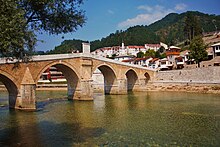Konjic (Serbian Cyrillic: Коњиц, pronounced [konj-its]) is a city and municipality located in the Herzegovina-Neretva Canton of the Federation of Bosnia and Herzegovina, one of two entities that make up Bosnia and Herzegovina. It is located in northern Herzegovina, around 60 kilometres (37 mi) southwest of Sarajevo, in a mountainous, heavily wooded area, and is 268 m (879 ft) above sea level. The municipality extends on both sides of the Neretva River. According to the 2013 census, the city of Konjic has a population of 10,732 inhabitants, whereas the municipality has 25,148.[1]
The city is one of the oldest permanent settlements in Bosnia and Herzegovina, dating back almost 4,000 years; it arose in its current incarnation in the late 14th century.
The area near the Konjic is believed to have been settled up to 4,000 years ago, and settlements around 2,000 years ago by Illyrian tribes travelling upstream along the Neretva river have been found.[2] Konjic was earliest recorded by name in the records of the Republic of Ragusa on 16 June 1382.[3]
The town, part of the Bosnian kingdom, was incorporated into the Ottoman Empire, of which the lasting feature for the town (apart from the many mosques and bringing of Islamic faith) is the Ottoman-inspiredbridge Stara Ćuprija which features in the town’s coat of arms, and later into the Austro-Hungarian Empire.[citation needed]

After World War I, the town, along with the rest of Bosnia and Herzegovina, became part of the Kingdom of Serbs, Croats and Slovenes later renamed Kingdom of Yugoslavia in 1929. During World War II, the town became part of the Independent State of Croatia, and following the war joined the Socialist Federal Republic of Yugoslavia. Between 1953 and 1979, a 611 square-metre atomic bunker, dug 300 metres into a mountain, known as ARK, was built secretly by the government in the Konjic municipality.[4]
The town grew significantly and prospered as a vibrant, multi-ethnic town with good transportation links (the town is on the railway between Sarajevo and the Adriatic Sea), the large Igman ammunition factory and Yugoslav Army barracks. These factors became one of the main reasons for the town’s conflict in the 1990s.[citation needed]